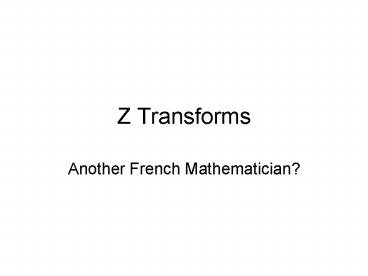Z Transforms PowerPoint PPT Presentation
1 / 30
Title: Z Transforms
1
Z Transforms
- Another French Mathematician?
2
Z Transforms
The Z transform is to discrete time systems as
the Laplace transform is to continuous time
systems.
The Fourier transform is the Laplace transform
evaluated on the jw axis.
The discrete Fourier transform is the Z transform
evaluated on a unit circle in the Z transform
plane.
3
Z Transforms
As with the Laplace and Fourier transforms, the Z
transform only if there is a region in the z
plane where the Z transform sum converges.
4
Z Transforms
The Z transform is a linear operation
To prove this
5
Z Transforms
The Z transform also has a time shifting property
This is easily proven
Changing variables
6
Z Transforms
There is a discrete time unit step function,
u(n). This is analogous to the continuous time
unit step, u(t)
The discrete time unit step is
7
Z Transforms
We can write a causal signal either this way
Or like this
8
Z Transforms
Lets derive some Z transform pairs. First,
though, we need several formulas dealing with
geometric series.
Heres a finite geometric series
Multiplying both sides by a
9
Z Transforms
If we subtract the last equation from the
preceding one
Solving for SN-1
Note that a can be real, imaginary, or complex,
but cannot be equal to 1.
10
Z Transforms
Now consider an infinite geometric series
For this to converge, aN must approach zero as N
approaches infinity. In other words,
If this condition is met,
11
Z Transforms
if a is complex, it may be written as
In which case r lt 1 is equivalent to
12
Z Transforms
Now lets find the Z transform of the discrete
time impulse
So
Now lets try the shifted impulse, d(n-k)
13
Z Transforms
Now, lets take the causal series
This converges if
14
Z Transforms
Using the formula for an infinite geometric
series, and substituting cz-1 for a
15
Z Transforms
Now lets try this one
Using Eulers formula
16
Z Transforms
for c in
But we can substitute
This gives us
17
Z Transforms
But this can be rewritten as
And this can be simplified as
18
Z Transforms
So we have this transform pair
A similar derivation yields this
19
Z Transforms
Uniqueness Problem
Recall that this is a transform pair
Now, consider the anticausal twin of cnu(n)
20
Z Transforms
This can be rewritten as
So we can derive its Z transform
21
Z Transforms
But this can also be written as
So
Using the geometric series formula
22
Z Transforms
We can rearrange this a bit more
But, we already derived this
23
Z Transforms
The only difference between the Z transform pairs
for the causal series and its anticausal twin is
the region of convergence - so we need to know
which series were dealing with. Normally it
will be the causal one.
Examples
24
Discrete Time Transfer Function
For a continuous time system, the transfer
function is
For a continuous time system, the transfer
function is
25
Discrete Time Transfer Function
We have two ways to find the transfer function
1. Take the Z transforms of the input and output
sequences X(z) and Y(z), then divide Y(z) by X(z)
2. Take the Z transform of the system impulse
response sequence
26
Discrete Time Transfer Function
Heres a difference equation for a generalized
discrete time system
Heres its Z transform, by inspection
27
Discrete Time Transfer Function
Rearranging,
So the transfer function is
28
Discrete Time Transfer Function
This can also be rewritten as
This is similar to the way we wrote the transfer
function of a continuous time system. The lks
and pks are the zeros and poles, respectively.
29
Discrete Time Transfer Function
Since the coefficients (ak and bk) are real
numbers, the poles and zeros must either be real,
or complex conjugate pairs.
Since the feedback coefficients (ak) of an FIR
system are all zero, the denominator of its
transfer function is 1. Therefore, an FIR system
has no poles. It may be referred to as an
all-zero system.
30
Discrete Time Transfer Function
Lets talk about the impulse response for a
minute. Suppose we have a discrete-time system
with an impulse response h(n), and we drive it
with an impulsive input
Then the response is
Or, in the Z transform domain,

